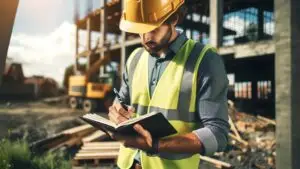1. introduction to defect detection in the construction industry
At the heart of construction lies the relentless pursuit of not just building, but improving and perfecting.
It’s about getting the best out of every project – for the clients, the users and the community.
Identifying and rectifying defects plays a crucial role in this.
It is not only a technical challenge, but also an opportunity to ensure quality and safety and to show what is possible with care and attention to detail.
1.1 Importance of defect detection for the construction industry
The ability to detect defects early is more than a quality feature; it is a sign of foresight and a sense of responsibility.
For large construction companies, effective defect detection can mean the difference between a smooth project and unexpected obstacles.
For the innovative minds among architects and planners, it opens up new opportunities to refine and realize their designs.
For small and medium-sized companies, it provides a way to use their resources wisely and make their projects successful despite limited resources.
For those working directly on site, it offers the opportunity to respond quickly and effectively to challenges.
And for those who care about quality and safety, it is an indispensable tool to meet the high standards they have set for themselves and their projects.
1.2 Overview of the contents
This guide takes you on a journey of discovery through the world of defect detection in the construction industry.
From the basics of the different types of defects to innovative detection methods and practical solution strategies – we cover it all.
You will learn not only how to identify typical and specific construction defects, but also how to address them effectively.
Through case studies and field reports, we offer you insights into successful strategies and let you learn from the experiences of others.
The goal is to provide you with the knowledge and tools to increase the quality and efficiency of your construction projects while minimizing risk and keeping costs in check.
2. basics of the types of defects in construction
The landscape of buildings is as diverse as the people who use them.
Each building tells its own story, and yet they all share a common chapter: the challenge of mastering defects.
In this section, we delve into the world of defect types, understand their meaning and learn how to classify them.
2.1 Definition and classification of defects
Defects in construction are deviations from the agreed or expected standards of construction quality.
They can occur at any stage of the construction process, from planning to execution and completion.
Defects can be divided into different categories based on their cause, their severity and their impact on the use of the building.
The most common categories include:
- Structural defects: Impairments that jeopardize the stability and safety of the building.
- Functional defects: Problems that limit the usability of a building or its parts.
- Aesthetic defects: Deviations that reduce the appearance and thus the visual impression of the building.
- Material defects: Defects resulting from the use of inferior or unsuitable materials.
2.2 Material vs. immaterial defects: an overview
The distinction between significant and insignificant defects is crucial for assessing the building quality and determining the necessary measures.
- Major defects are those that have a significant impact on the safety, functionality or value of the building.
They require immediate attention and often extensive measures to rectify them. - Minor defects, on the other hand, do not significantly affect the safety or general use of the building.
They can usually be rectified with little effort and without major impairment.
Methods for detecting construction defects
| Method for defect detection | Suitable tools |
|---|---|
| Visual inspection | Digital camera or smartphone, notepad and pen, checklists |
| Thermography | Infrared camera, thermography software |
| Endoscopy | Endoscopic camera, flexible guide tubes |
| Humidity measurement | Moisture meter, hygrometer |
| Sound measurement / Acoustic testing | Sound level meter, ultrasonic tester |
| Laser scanning and 3D modeling | 3D laser scanner, CAD software |
| Drone inspection | Drone with HD camera, image analysis software |
| Crack measurement | Crack width measuring device, crack monitors |
| Structural monitoring and analysis | Sensors for structural health monitoring (SHM), analysis software |
| Material testing (e.g. concrete testing) | Schmidt hammer, concrete testing equipment |
| Digital documentation and defect management | Construction software such as XBuild, mobile apps for defect recording |
3. building defects and their special features
In the world of construction, every project is unique – but one constant remains: the need to effectively address construction defects.
These sections highlight typical construction defects and the most advanced methods for detecting them.
3.1 Typical building defects and their causes
Building defects vary in form and extent, but some are particularly common.
The most common include cracks in the building fabric, problems with damp insulation, leaking windows and doors and defects in the electrical installation.
These problems can be caused by a variety of factors, including the use of poor quality building materials, poor workmanship, design flaws or natural influences such as subsidence of the building.
Early identification and rectification of such defects is crucial to ensure the long-term integrity and functionality of the building and avoid more extensive damage that could lead to significant additional costs.
3.2 Detection of construction defects: Methods and tools
The modern construction industry has access to a wide range of defect detection methods and tools, ranging from traditional visual inspections to advanced technological solutions.
XBuild, an advanced construction software, is revolutionizing defect detection, documentation and remediation in the construction industry.
With the ability to capture defects directly on site via mobile devices and share them instantly with the team, XBuild significantly speeds up the process.
The software enables automatic task assignment and real-time monitoring of rectification progress, improving efficiency and fostering team communication.
XBuild represents the modern solutions that make construction projects more efficient and of higher quality.
4. material defects and their relevance in building law
4.1 Definition and examples of material defects
Major defects are construction defects that significantly impair the usability of a building.
These include, for example, structural defects that jeopardize stability, significant moisture damage or serious deviations from building standards.
Such defects not only represent a safety risk, but also have a negative impact on the value of the property
4.2 Legal consequences of material defects in building law
In construction law, significant defects have far-reaching consequences.
Under certain circumstances, they entitle the client to reduce the remuneration for the work, to withdraw from the contract or to claim damages.
The exact legal steps to be taken depend on the individual case and should always be accompanied by a specialist lawyer.
Media recommendation: A short explanatory video that illustrates the legal consequences of significant defects in construction law.
Classification of construction defects
Safely determine and evaluate
Construction defects Categories
- Design error
- Material defects
- Execution error
Info:
Defects caused by planning or construction errors.
Examples:
Incorrect calculations, inadequate specifications.
Info:
Defects caused by inferior or unsuitable materials.
Example:
Use of inferior concrete, wrong choice of materials.
Info:
Defects caused by errors during construction.
Example:
Poor craftsmanship, disregarded building regulations.
Severity of the defects
Minor defects
Info:
Minor defects that pose no immediate danger and can be easily rectified.
PRIO C
Examples:
Scratches on surfaces, minor cracks.
Medium defects
Info:
Defects that need to be rectified, as they can lead to major problems in the long term.
PRIO B
Examples:
Moisture damage, inadequate insulation.
Serious defects
Info:
Defects that significantly impair the safety and functionality of the structure and require immediate action.
PRO A
Examples:
Structural instability, considerable settlement cracks.
Do you need support with your choice
Finding the right tool is important for you - we are happy to help.
Find THE solution nowCommon causes of Construction defects
Planning errors
Cause:
Insufficient or faulty planning.
Material defects
Cause:
Use of inferior or incorrect materials.
Execution error
Cause:
Errors during construction, lack of specialist knowledge.
Environmental influences
Cause:
Insufficient or faulty planning.
Consequences of Construction defects
Construction defects can pose significant safety risks to the occupants or users of a building.
For example, structural weaknesses can lead to collapse, while electrical defects can cause fire hazards.
These hazards can lead to accidents, injuries or even fatalities and often require immediate action to avert danger.
The rectification of construction defects causes additional costs that can significantly exceed the original construction budget.
Repair work, additional material costs and possible contractual penalties for construction delays contribute to these unexpected expenses.
In the long term, these costs can affect the profitability of the construction project and increase the financial burden for builders.
Identifying and rectifying construction defects often leads to significant delays in the construction process.
This can postpone the completion date of a project and cause additional costs for extended working hours and machine rentals.
In addition, delays can affect contractual obligations and strain the relationship between client and contractors.
Construction defects can significantly reduce the market value of a property.
Potential buyers or tenants are less willing to pay a high price for a building with known defects, making it more difficult to sell or rent.
In the long term, this can affect the return on investment and jeopardize the financial success of the project.
Construction defects can severely damage the reputation of and trust in the companies involved in construction.
Repeated defects or serious errors lead to customers and partners avoiding the company and spreading negative reviews or reports.
In the long term, this can lead to a decline in orders and economic losses.
Measures for Remedy of defects
Early detection
Regular inspections and quality controls.
Dokumentation
Detailed recording and documentation of defects.
Immediate measures
Fast and efficient elimination of identified defects.
Long-term prevention
Improvement in planning, material and execution quality.
Test 30 days free of charge
Try it out for yourself at your leisure?
Sure, this way please.
5. typical defects during building acceptance
5.1 Identification of typical defects during building acceptance
Typical defects such as inadequate surface finishes, faulty installations or defects in the roof area are often found during the building inspection.
A thorough inspection by the building owner or an independent expert is crucial in order to identify such defects.
5.2 Prevention and remediation strategies
Prevention strategies include detailed planning and execution monitoring.
If defects already exist, it is essential that they are rectified quickly and professionally in order to avoid further damage and costs.
6. practical guide to the detection and assessment of construction defects
6.1 Step-by-step guide to defect detection
A systematic approach is crucial for the effective detection of construction defects.
This includes visual inspection, the use of specific measuring instruments and, if necessary, the commissioning of experts for special testing procedures.
6.2 Assessment of defects: Criteria and procedures
The assessment of defects requires specialist knowledge of the permissible tolerances and the possible effects on the use of the building.
Normative specifications and technical standards play a key role here.
Recommendation: XBuild Webinar Part 2 on 29.09.2024 at 16:30 – (Registration follows > be notified)
7. strategies for action and solutions
7.1 Dealing with material and immaterial defects
Dealing with defects requires a differentiated view of the type of defect and the possible consequences.
While major defects require immediate action, minor defects can often be rectified at a later date or in consultation with the client.
Advice video:
7.2 Technological aids and software solutions
Modern technologies such as construction software and mobile apps offer efficient solutions for defect management.
They enable defects to be recorded, documented and communicated quickly.
Recommendation: Book a free demo presentation of the latest technological tools and software solutions for defect management – XBuild.
The 6 most common Construction defects in 2024
Structural deficiencies
Problems in the structure, such as cracks in the foundations or uneven settlement, can significantly affect the stability and safety of a building.
These defects are often caused by poor construction work or inferior materials.
Water ingress and moisture damage
Water ingress due to inadequate sealing or defective roof structures can lead to mold growth and material deterioration.
This is one of the most common defects and often has a serious impact on the structure and use of the building.
Poor workmanship
Poorly executed construction work, such as improper pipe laying, inadequate electrical installations and inaccurate masonry work, lead to long-term problems.
These defects are often due to inadequate training and supervision of construction workers.
Faulty drainage systems
Defects in the drainage systems or rainwater drainage can lead to standing water that affects foundations and underground structures.
This can necessitate costly repairs and extensive renovation work.
Electrical and mechanical system faults
Problems in the electrical systems and HVAC (heating, ventilation, air conditioning) are common.
Faulty wiring or poorly installed HVAC systems can lead to safety risks and energy inefficiency.
Design error
Construction errors resulting from inadequate planning and design can impair the functionality and safety of the building.
This includes inadequate structural support or incorrect room layouts.
Summary and outlook
Key findings and recommendations
Dealing with construction defects reveals the importance of careful planning, execution and monitoring in the construction industry.
The solutions and strategies presented offer valuable approaches for optimizing this process.
Future trends in defect detection and rectification
Innovations in construction technology and project management promise continuous improvement in methods for identifying and rectifying defects.
Sustainable construction methods and digital tools will play a central role in this. Further content: Bauherren Schutz e. V.: The 10 most common construction defects – https://www.bsb-ev.de/themenratgeber/neubau/baumaengel/die-zehn-haeufigsten-baumaengel






